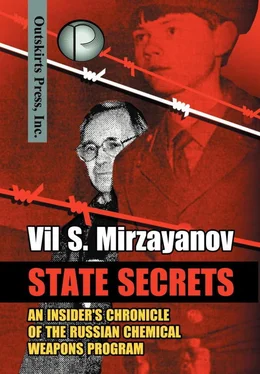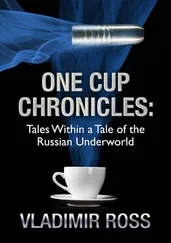In the early 1980s, the Dzerzhinsk branch of the Special Design Bureau began making rather good gas chromatographs with a wide range of detectors including the one we needed – the thermionic detector with a rubidium sulfate tip. Unfortunately, it was very unstable in work, and its performance was changing all the time, making it practically useless for quantitative analysis of phosphorous-containing compounds.
Once, Bogomazov asked me for a used detector tip, so I gave it to him. I watched as he manipulated the head in some way, with the help of a solution, but I was rather skeptical about his attempts.
The next day, Bogomazov returned the old detector tip to me, but now it was restored and looked like a new one. I was intrigued and both of us stayed to work into the evening to test it out. Our tests showed splendid results. The detector showed a stable zero background and high sensitivity – no worse than the sensitivity guaranteed by Varian. We kept testing the detector for a whole week and results were always good. Our inventor soon restored all of my used detector tips, and solved the problem of purchasing new ones from the American manufacturer.
However, Bogomazov was not content with what had been achieved – his nature longed for grand-scale achievements. On the basis of this success he decided to remodel the thermionic detector of the Tsvet-110 gas chromatograph.
After he had made some changes, the domestic thermionic detector had practically the same sensitivity, selectivity, and stability characteristics as its American counterpart. Bogomazov immediately suggested starting up a plant at GOSNIIOKhT for manufacturing thermionic detectors for sale.
Although Director Patrushev supported Bogomazov’s idea, this plan was never realized. The market for these detectors was very limited, and the artificially low prices for chromatographs, fixed by Price Commission of the U.S.S.R. Council of Ministers, did not allow them to sell detectors at a price that would even cover the costs.
Bogomazov would not have been himself, if he allowed that to stop him. He always tried to get the maximum benefit from all his achievements, although that sometimes brought him bitter disappointment. He realized that he would never make a successful career searching for toxic agents capable of breaching the gas-mask filter, so he decided to switch over to thermionic tips.
At that time, Bogomazov’s stepbrother was the director of a large precious stone factory in Moscow. Leonid Brezhnev’s daughter often visited that factory, and she liked to fill up her handbag with diamond jewelry made there.
Bogomazov made contacts there with some people who provided services to powerful people. In this way, he met the future mayor of Moscow, Yuri Luzhkov, who was then the director of the NPO Khimavtomatika. At that time, Luzhkov enjoyed the personal confidence of the Minister of Chemical Industry, Leonid Kostandov, and ran errands for him.
Khimavtomatika also had a section that participated in the Foliant program. In particular, it designed an automatic line for taking samples of Substance 33, and it arranged for their delivery to a laboratory at the chemical plant in Novocheboksary. Luzhkov was Director of Khimavtomatika and in charge of Khimavtomatika’s branch in Dzerzhinsk, so he was directly interested in improving the quality of Tsvet-110 chromatographs.
Evgeni Bogomazov with his innovative ideas came in very handy, and Luzhkov provided him with a laboratory and equipment at Khimavtomatika. Bogomazov began working there without pay, in the evenings and on his days off, mounting thermionic detector tips on new chromatographs.
It wasn’t at all difficult for the MACD graduate to arrange to have the new director of GOSNIIOKhT, Petrunin, visit Khimavtomatika. He went along with Luzhkov and “accidentally” visited the room where Bogomazov and his assistant were working. Luzhkov then told Petrunin about Bogomazov and his achievements, and he added that Bogomazov had to work at Khimavtomatika in the evenings because he probably couldn’t find understanding at GOSNIIOKhT.
Soon after that, Petrunin sent for Bogomazov and appointed him head of a new laboratory for the analysis of field test samples. That was the hour of Bogomazov’s shining glory.
It should be said here that as the head of the field test laboratory, Bogomazov greatly helped GOSNIIOKhT to add a new substance, chemical agent A-230, to the Soviet Army’s chemical warfare arsenal.
Actually, the ongoing tests of A-230 on the new test site in Nukus (in Kara-Kalpakia, Uzbekistan) were not particularly encouraging. Possibly it was because the test site, which was built in 1983, had low-skilled personnel and the set-up and technical support were poor. Or maybe there were some other reasons.
At Nukus, the old cholinesterase method was used, and the faulty analysis it gave could well have been the main cause of failure. However, you can’t exclude the possibility that the military authorities were opposed to promoting A-230 as a chemical agent.
Before that I was already aware of a number of cases in which the military had some field analysis results adjusted downwards. This information came from a number of sources, including GOSNIIOKhT employees.
The situation dramatically improved in 1986, when Bogomazov was appointed Research Director in charge of all testing carried out by GOSNIIOKhT on the Nukus site. At that time he began working there on a regular basis. With his characteristic energy, Bogomazov had the test site provided with all the necessary equipment and instruments. It was staffed with the best specialists in analytical control, who were using chromatography for the analysis of samples on the highest scale. Sometimes the number of samples reached one thousand. The specialists who were sent to work in Nukus from GOSNIIOKhT and its branches saw their salaries raised.
Bogomazov quickly found a common language with the military people, as he had known many of them since his student days at MACD.
Possibly he could manipulate test results himself and adjust them upwards. However, I knew that the fate of the tests would not be decided by Bogomazov’s ability to manipulate the facts, but by more practical considerations. The military-chemical complex was badly in need of a stimulating factor, as Mikhail Gorbachev declared under perestroika.
If some sensational result was achieved by the military-chemical complex, this could engender such a stimulating factor, but that was possible only through close cooperation between civilian and the military leaders of the military-chemical complex.
In 1987, Petrunin announced at a party meeting that GOSNIIOKhT had achieved such a sensational success, one which only could happen once in every 40 years. He said the success could be called ground-breaking without any exaggeration.
At that meeting Bogomazov was sitting solemnly at the presidium, literally shining with happiness. He was so overcome with emotion that he occasionally closed his eyes for a long time. Almost everyone present at the meeting assumed that Petrunin was talking about the successful completion of tests on the new chemical agent A-230.
Still, I think that more than a few of the people present wondered: Why do we need all of that, when our country is suffering from acute shortages and everything is on the slippery slope down to Hell?
My story about Bogomazov would not be complete, if I didn’t tell you about his downfall.
Bogomazov achieved the height of his success in those days, but his active nature would not let him rest on his laurels. Time was working against him at GOSNIIOKhT, and his envious colleagues, and especially his boss Nikolai Kuznetsov, could not bear their lucky colleague’s success any more. Little by little, Bogomazov was pushed away from other promising research projects, in particular from testing the new binary weapons.
Читать дальше












